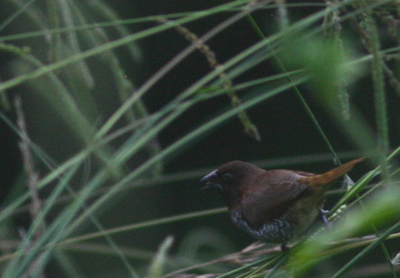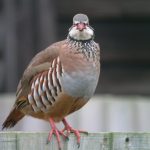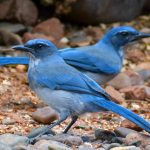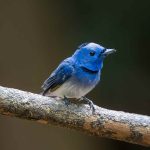Even after unparalleled birding in Bolsa Chica and San Joaquin Wildlife Sanctuary, Amy and I chose to press on. We eschewed further coastal wetlands at Newport’s Back Bay for the leafy shelter of Huntington Beach Central Park. A big draw to Huntington was Corey’s report of Tricolored Blackbird at the horse stables, right along the edge of an active disc golf course. Alas, my otherwise reliable friend neglected to mention that he spotted said blackbirds in winter until we’d already arrived at the stables, at which point it was apparent that our quarry was nowhere in sight. That’s alright though, as there was plenty more to see at Huntington Park, or so we thought.
The woods, a welcome respite after a long day in the California sun, were quiet, some might say too quiet. Yes, Black Phoebes, Bushtit, Yellow Warbler, House Finches, and swallows both Barn and Tree were fairly easy to come by, but that was about it. Treetops held some more interesting inhabitants with a Spotted Towhee in song here and a sly Sharp-shinned Hawk dining silently on some unidentified rodent there. But those birds along with innumerable rabbits and squirrels presented the proponderance of (non-human) wildlife present.
One exception was a hummingbird gracious enought to perch on a branch long enough for us to eke out an identification of Black-chinned, a life species that I wasn’t even alert enough to seek out. Black-chinned Hummingbirds, close cousins to the ubiquitous Ruby-throated Hummingbird of the eastern U.S., are considered one of the most common hummingbirds in the west during summer months. Oddly enough, this was the only one we saw all day.
Speaking of odd, our most unexpected encounter was of the exotic kind. While we were walking, I observed a small flock of seemingly unfamiliar birds in a small tree, but in the late day sun, I wrote them off as House Finches. Coming back around, we encountered the birds again, this time in some tall reeds. A better view revealed a most surprising species: Nutmeg Mannikin! Nutmeg Mannikins in the U.S. are either released birds or descendants of the same. These small birds have snub-nosed finch bills and intriguing barring on their breasts. The male of the species, one of four birds in the group we observed, is adorned in rich cinnamon plumage much brighter than that of females and juveniles. Considering the mixed nature of the flock, I’d guess that this feral clan is sustainable.

Nutmeg Mannikin
The mannakins signaled the end of our wild day of California birding. While I was graced with Hooded Orioles, Western Kingbirds, and Common Ravens roosting in the palms outside my hotel window right across from Angel Stadium and added Heerman’s Gull and both Brandt’s and Pelagic Cormorants at my beloved Laguna Beach, my mind turned of necessity to the business that brought me cross-country. Anyway, after this avian extravaganza in the company of the most estimable and indefatigable Amy Hooper, my hunger for California birds was, at least temporarily, sated!













Oops…well, you didn’t ask in advance what time of year they were there! 🙂
Not knowing much about birds (but still read this blog) I find it amazing how you can identify so many of the birds here in california that I probably see all the time but have no idea what they are. Different folks truly see what’s around us differently!
Hey Webomatica, you’re right about how a little training can open your eyes to a world most people don’t notice. Keep reading and you may start noticing these things yourself!
What are those birds at the Angel Stadium that dive after the sphinx moths? They are so fast and magnificent!
Debi, I can’t say for sure since I’ve never seen a game at Angel Stadium but I’d bet they’re some species of swallow.
Thanks Mike. That would make sense. They appear to be yellow? and Brown? but hard to tell as they fly so very fast!
I live near the Bolsa Chica wetlands. I want to have a bird feeder. What type of food should I get, and what type of feeder should I get? I already have a Hummingbird feeder.